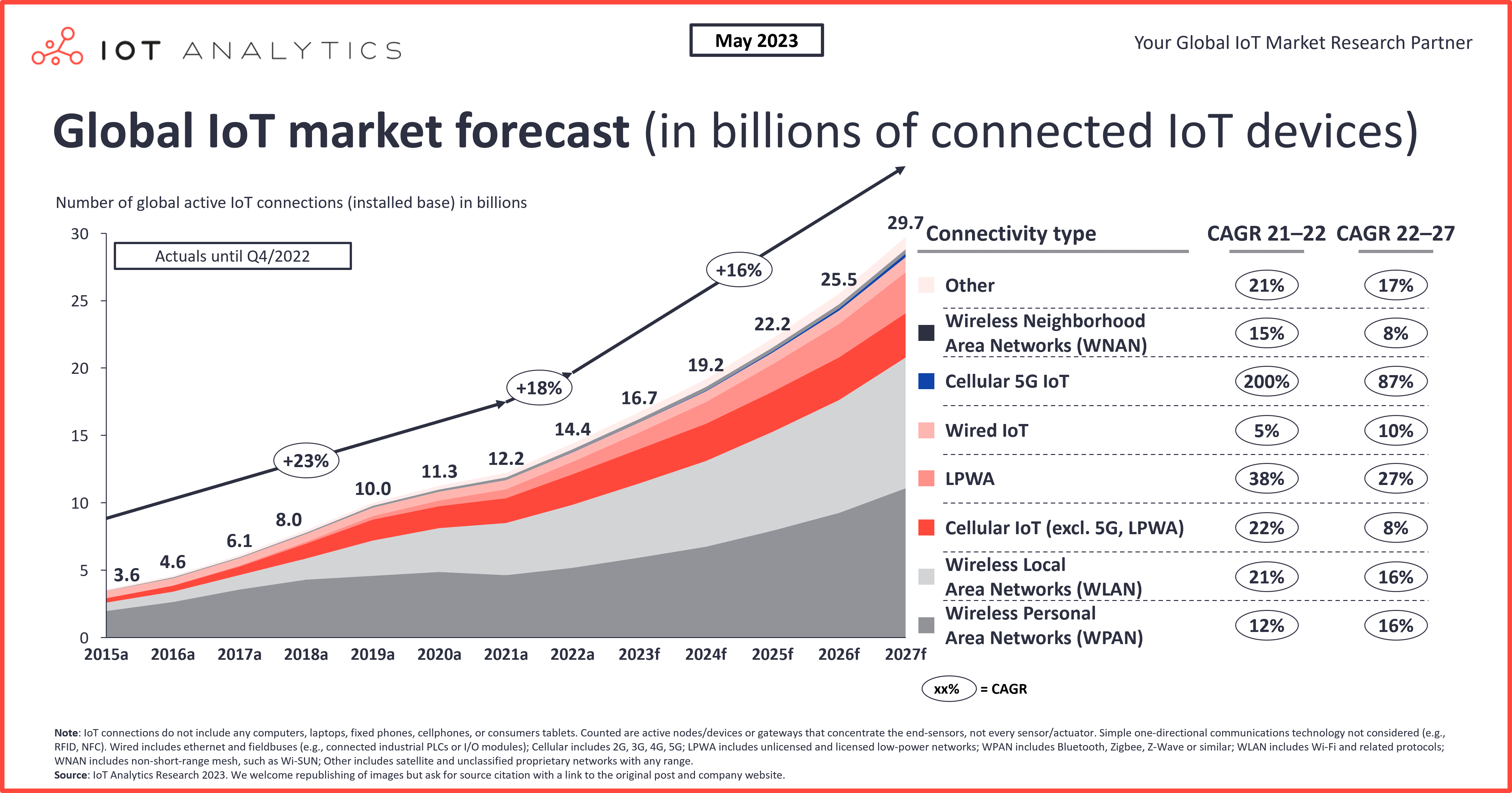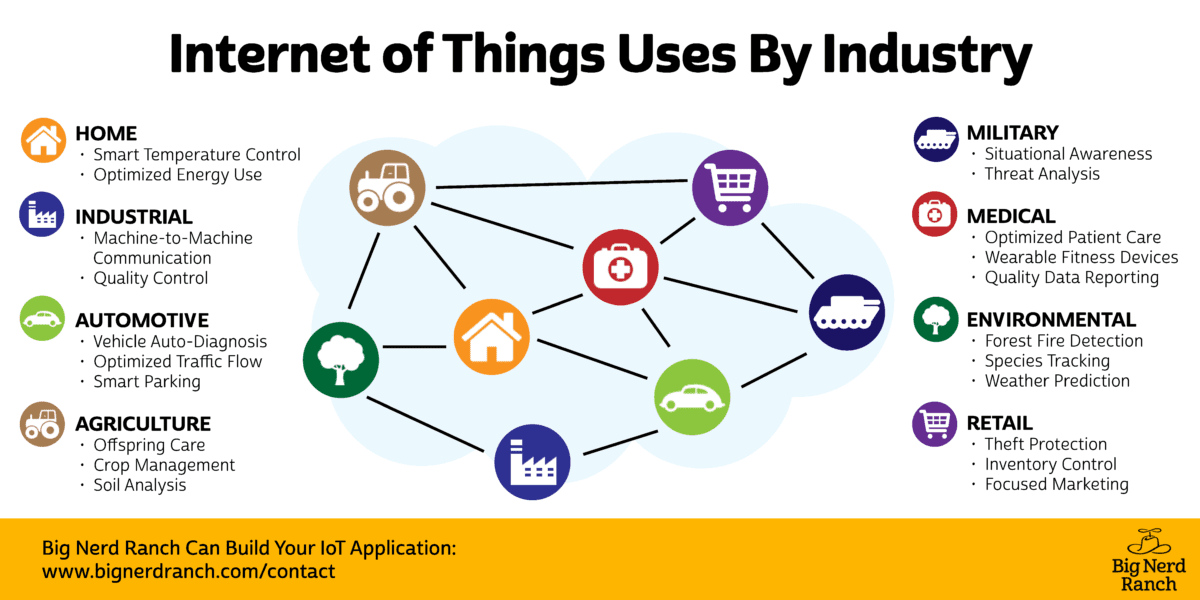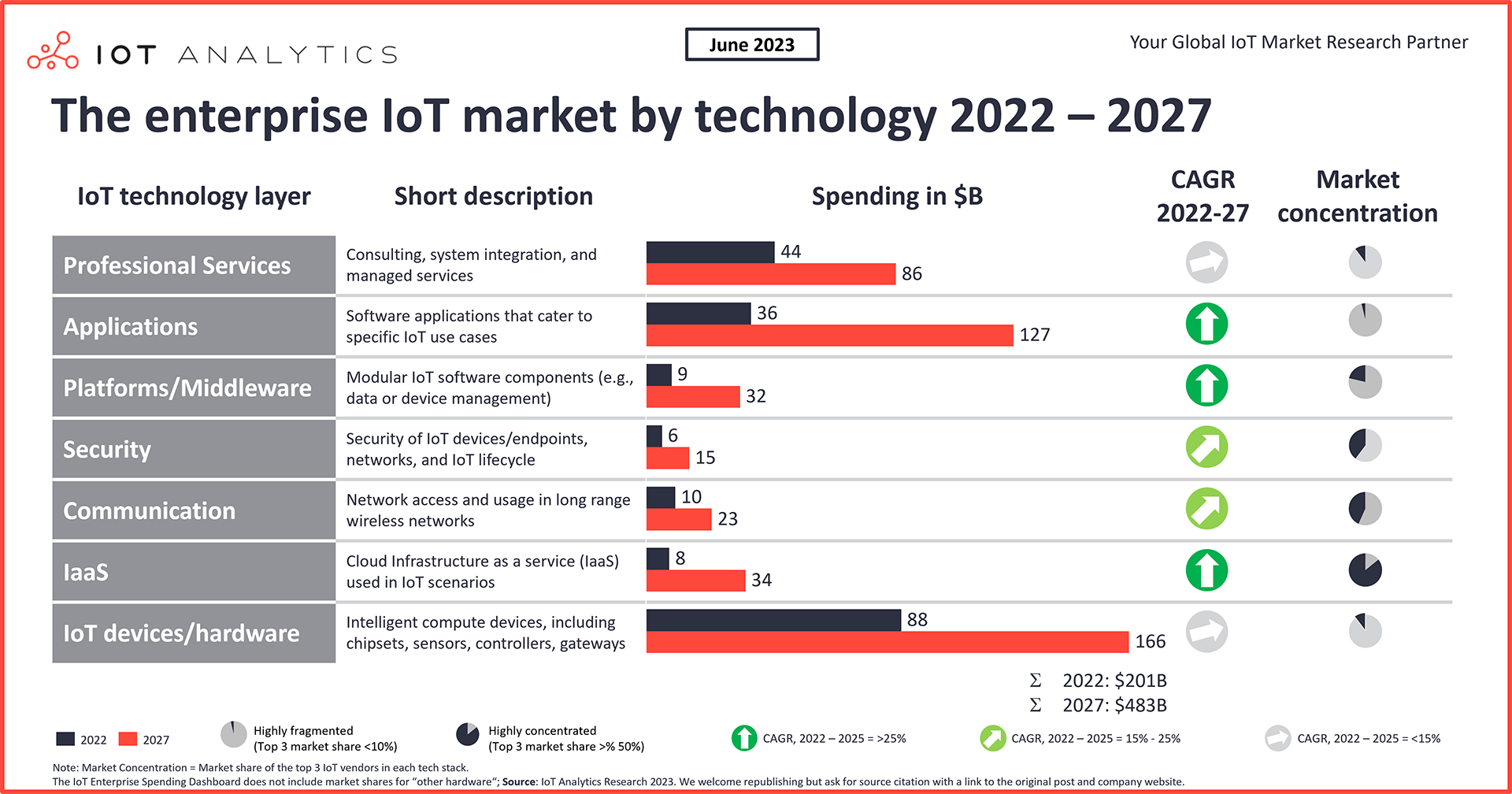The Big Trends - Part 9: The Internet of Things

Reviewed by Bailey Pemberton, Michael Paige
“If you think that the internet has changed your life, think again. The Internet of Things is about to change it all over again!” — Brendan O’Brien
This is part 9 of our ‘Big Trends’ series, and we are looking at another emerging trend, the Internet of Things (IoT).
If you’re not familiar with this space, Oracle describes it as :
“The network of physical objects —“things”—that are embedded with sensors, software, and other technologies for the purpose of connecting and exchanging data with other devices and systems over the internet. These devices range from ordinary household objects to sophisticated industrial tools.”
This market has grown rapidly at around 23% annually over the last 8 years, and while growth may be slower over the next 8 (16-18% annually), it has still got plenty of room to grow, and we’ll explain why.
Connected Devices: The Internet of Things
As the cost of connectivity has fallen, the number of connected devices has increased.
There are now over 15 Billion Devices connected to the internet.
Considering there’s 5.19 Billion people connected to the internet, that’s an average of 3 devices per person.
And guess what, that number of connected devices is expected to double in the next five years (and could become roughly 5.5 devices per internet connected person).
Initially it was mobile phones and computers that were connected, but connectivity is increasingly a feature of vehicles, machinery, appliances and even buildings.

Just as mobile phone adoption increased as prices fell, falling component prices has created new viable use cases.
IoT sits at the intersection of automation, AI, big data, cloud computing and edge computing.
The concept of smart devices is closely tied to trends like electrification , healthtech and agtech that we have covered in previous pieces during our Big Trends series.
IoT Use Cases
If you’ve been in the market for a new vehicle or home appliance recently, you may have already asked yourself, “ why does this product need to be connected to the internet? ”.
And while it all may seem like a redundant step towards making products more expensive (or speed up planned obsolescence as technology improves), there are some super beneficial applications of having the things we use in our day to day lives connected to the internet.

Here are just a few of the real world applications of IoT:
-
🚚 The logistics and supply chain industries are being revolutionized by IoT technology which allows shipments and individual products to be tracked in real time and efficiently routed.
- This allows tighter inventory management and planning, and provides transparency to all participants.
- Going forward, IoT technology will be integral to autonomous delivery, whether by vehicles or drones.
-
🏥 The healthcare industry is also making increasing use of connected devices.
- From activity trackers, and smartwatches to remote monitoring of glucose levels, heart rates and symptoms of chronic conditions, connectivity allows healthcare professionals to provide care to more patients, wherever they are.
-
🚜 Connected devices and machines are becoming increasingly common in agriculture. These range from monitoring devices all the way to autonomous farm machinery.
- Monitoring devices allow farmers to react quickly to changes in the environment, informing them of appropriate times to harvest, and helping them catch diseases early.
-
🏙️ ‘Smart Cities’ use data from a range of sensors and devices to manage traffic and parking, detect leaks, and manage power consumption.
- The security industry is already reliant on various types of cameras, including AI powered smart cameras that can detect suspicious activity.
-
🏠 Home Automation is becoming increasingly ubiquitous.
- Apple, Google, Samsung, Amazon and many other companies already provide apps that allow you to monitor, control and automate appliances, lights, and security systems.
- This trend is accelerating as more devices and appliances are replaced with new ‘smart devices’.
- For consumers, there’s a type of network effect at play: if you already have some smart devices that you control with an app, the next time you replace a device or appliance you’ll be more likely to choose one that interacts with the same app.
The Opportunity
As touched on previously, a growing array of devices connected to the internet has massive implications for automation, AI, big data, cloud computing and edge computing.
Just think, with more devices connected to the internet, the more information that will be gathered. This information will need to be stored, and interpreted. Our internet infrastructure ( the cloud and consequently, data centers ) will need to be able to support billions of new devices coming online.
All this new data and information now becomes useful. An interconnected series of devices allows for simple tasks to be automated.
Cars can communicate with each other to form a grid of self-driving vehicles that could revolutionize road travel. Stop signs and traffic lights could become a thing of the past.
A collection of smart devices can begin to power smart homes, maintain lighting, resource management, and security systems. You could be several hours away from home and ensure that your property is secure, all appliances are turned off, helping you save on your energy bills.
More devices also means a greater need for cybersecurity. If your refrigerator or watch is able to track key personal information on you, you’d better hope it remains secure.
It’s difficult to put numbers on the IoT industry because it overlaps with so many other industries - but as a reference point, Global IoT Analytics (a wealth of IoT research and analysis) also sees enterprise IoT spending doubling from $238 billion in 2023 to $483 billion in 2027.

IoT Companies Who Could Benefit
There are hundreds of companies exposed to the IoT space in various ways. Firstly, we have the companies that manufacture the components essential to connectivity, including Cisco, Intel, Broadcom, NXP Semiconductors , and Skyworks.
In addition there are all the companies associated with edge computing which include Cloudflare, Edgio, Fastly , Akamai Technologies.
Within such a diverse industry there are opportunities for smaller companies to develop niche products. Companies that specifically focus on IoT include Acuity Brands, Johnson Controls, Alarm.com, Samsara, Impinj, and Sierra Wireless.
As connected devices and machines become more powerful they gather more data. That data needs to be organized, stored and analyzed which means all the companies associated with cloud computing, data analysis and AI are also exposed.
Amazon AWS, Microsoft, Google and IBM all provide platforms for IoT developers.
Will The IoT Make My Life Easier?
Whether you like it or not, greater interconnectivity of devices is a trend that won’t reverse any time soon.
A more pertinent question to ask would be whether this trend will materially benefit your life? The answer is most likely: Yes, but in ways you probably can’t envision.
Depending on your own personal preferences, increasing device connectivity could be something you reject in your personal life. Be it for data privacy reasons, cost reasons, or just to try and maintain simplicity in your life.
As far back as 2018, articles were already being written questioning whether we’re “in too deep” when it comes to how connected our lives are. Since then, the amount of internet connected devices has more than doubled from 8 Billion to 16.7 billion.
We can see it now in the increase in interest for “dumbphones” (phones that intentionally aren’t connected to the internet to encourage a reduction of screen time). People aren’t entirely comfortable with digitizing their entire lives and that’s ok. Considering that the average worker is spending more time in front of screens than ever before, it could be a form of mental retreat from an “always-on” lifestyle.
However, even if you reject increasing connectivity in your personal life, you will likely still be a beneficiary of the Internet of Things. Be it through applications in logistics, smart cities or even other vehicles on the road, the IoT will likely improve your life without you realizing it.
It’s okay to be a bit ambivalent about it as well. You can appreciate the increased efficiencies brought about by automation and greater access to data, but you could also be concerned about your own personal privacy. A great suggestion would be to remain vigilant about your own data. Be very conscious of who you give it to. Welcoming more technology into your life can improve many aspects but it’s important to exercise caution.
And of course, like most big trends, you don’t need to be exposed first-hand to the trend to potentially benefit financially from it. You may develop an investment thesis about how the IoT is going to revolutionize certain industries or our lives on the whole. Simply having ownership exposure to it can be more than enough for some people who acknowledge the trend, but wish to keep it at arms length.
What Else is Happening?
First a recap of the key data releases we mentioned last week…
- 🇦🇺Australia’s central bank left rates unchanged at 4.1% for the third consecutive month, as it was expected to do.
- RBA governor Philip Lowe said inflation had passed its peak, but also added that CPI is “still too high and will remain so for some time yet".
- 🇦🇺 Australia’s economy grew 2.1% year-on-year in the second quarter according to the Australian Bureau of Statistics.
- This was slower than the 2.4% recorded in the first quarter, but ahead of the 1.4% expected by economists.
- The economy benefited from rising services exports and inbound travel, while falling inventories and consumer demand weighed on growth.
- 🇩🇪 Germany’s trade surplus narrowed to $15.9 billion in July, from $18.7 billion in June.
- This was a surprise to economists who had expected it to widen to $19.1 billion. Exports fell due to falling demand for autos and industrial equipment, while imports rose slightly.
And then, a few news items that we thought were worth noting…
- 📱 Apple will be launching the iPhone 15 on Tuesday. The Wall Street Journal has reported that the premium versions of the phone will come with steep price hikes.
- These price hikes will reflect just how much pricing power Apple has, and how financially stretched its loyal fans are. It will all depend on how ready users are to switch the the rumored USB-C port included on the upcoming phone.
- Previous price hikes have contributed meaningfully to Apple’s revenue and margins, but some analysts aren’t sure this trend can continue. Let’s see what happens.
- 🖥 The highly anticipated IPO of chip designer Arm Holdings plc is due to go ahead later in September with a valuation of between $49 and $52 billion.
- This is quite a lot lower than was indicated just a month ago - but would still make it the third largest IPO ever for the Nasdaq.
- Tech giants Apple, Alphabet and Nvidia are all reportedly investing in the public offering. Nvidia was previously blocked by regulators when it tried to acquire the company.
Key Events During the Next Week
In the US the key data for the week will be consumer inflation (CPI) data on Wednesday, followed by producer price inflation on Thursday. US retail sales data is also due on Thursday.
In the UK employment data is due on Tuesday and GDP growth data for the second quarter on Wednesday.
The European Central Bank will be announcing its interest rate decision on Thursday.
Just two large companies, Oracle and Adobe will be reporting quarterly results this week.
Have feedback on this article? Concerned about the content? Get in touch with us directly. Alternatively, email editorial-team@simplywallst.com
Simply Wall St analyst Richard Bowman and Simply Wall St have no position in any of the companies mentioned. This article is general in nature. Any comments below from SWS employees are their opinions only, should not be taken as financial advice and may not represent the views of Simply Wall St. Unless otherwise advised, SWS employees providing commentary do not own a position in any company mentioned in the article or in their comments.We provide analysis based on historical data and analyst forecasts only using an unbiased methodology and our articles are not intended to be financial advice. It does not constitute a recommendation to buy or sell any stock and does not take account of your objectives, or your financial situation. We aim to bring you long-term focused analysis driven by fundamental data. Note that our analysis may not factor in the latest price-sensitive company announcements or qualitative material.

Richard Bowman
Richard is an analyst, writer and investor based in Cape Town, South Africa. He has written for several online investment publications and continues to do so. Richard is fascinated by economics, financial markets and behavioral finance. He is also passionate about tools and content that make investing accessible to everyone.

